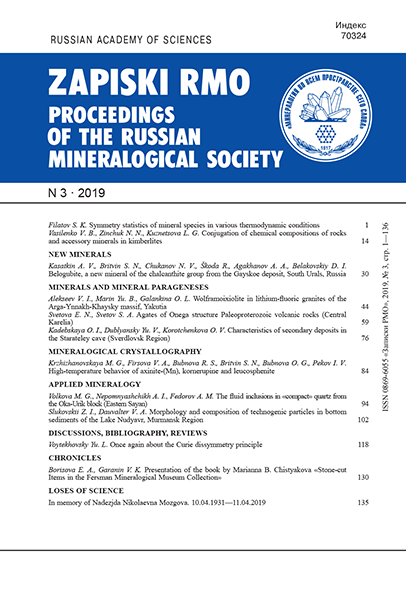High-temperature behavior of axinite-(Mn), kornerupine and leucosphenite
- Authors: Krzhizhanovskaya M.G.1, Firsova V.A.2, Bubnova R.S.2, Britvin S.N.1, Bubnova O.G.1, Pekov I.V.3
-
Affiliations:
- Saint-Petersburg State University
- Institute of Silicate Chemistry of Russian Academy of Sciences
- Moscow State University
- Issue: Vol 148, No 3 (2019)
- Pages: 84-93
- Section: Mineralogical Crystallography
- URL: https://journals.eco-vector.com/0869-6055/article/view/11360
- DOI: https://doi.org/10.30695/zrmo/2019.1483.06
- ID: 11360
Cite item
Abstract
In situ high-temperature powder X-ray diffraction (HTPXRD) and differential scanning calorimetry (DSC) of three natural borosilicates have been performed in the temperature range of 25—1200 °С. Axinite-(Mn) melts incongruently at 900 °С forming anorthite and bustamite. Leucosphenite decomposes at 850 °С to fresnoite and cristobalite. According to DSC data, kornerupine decomposes at 1177 °С and sapphirine, indialite, and spinel were observed as the products of kornerupine heating. The calculation and orientation of thermal expansion tensor have been performed using HTPXRD data. The study showed that the borosilicates expand weakly and almost isotropically. The average volumetric thermal expansion coefficients are 21.3, 22.7, and 32.9 ∙ 10–6 °C–1 for axinite-(Mn), kornerupine, and leucosphenite, respectively. Leucosphenite has a maximum volumetric expansion most likely due to the pronounced layered character of the crystal structure. The least symmetric structure of axinite-(Mn) has the maximal anisotropy of thermal expansion in the temperature range of 600—900 °C.
Full Text
About the authors
Maria G. Krzhizhanovskaya
Saint-Petersburg State University
Author for correspondence.
Email: mariya.krzhizhanovskaya@spbu.ru
ORCID iD: 0000-0002-1380-7458
Scopus Author ID: 6602302951
ResearcherId: K-7045-2013
Assistant Professor of Crystallography Department, Institute of Earth Sciences
Russian Federation, 199034, St. Petersburg, University Emb., 7/9Vera A. Firsova
Institute of Silicate Chemistry of Russian Academy of Sciences
Email: va_firsova@mail.ru
Senior Scientist
Russian Federation, 199034, St.Petersburg, Makarova Emb, 2Rimma S. Bubnova
Institute of Silicate Chemistry of Russian Academy of Sciences
Email: rimma_bubnova@mail.ru
Head of Structural Chemistry Lab.
Russian Federation, 199034, St.Petersburg, Makarova Emb, 2Sergei N. Britvin
Saint-Petersburg State University
Email: sergei.britvin@spbu.ru
Professor, Crystallography Department, Institute of Earth Sciences
Russian Federation, 199034, St. Petersburg, University Emb., 7/9Olga G. Bubnova
Saint-Petersburg State University
Email: olga.bubnova@spbu.ru
Leading Researcher of XRD center
Russian Federation, 199034, St. Petersburg, University Emb., 7/9Igor V. Pekov
Moscow State University
Email: igorpekov@mail.ru
Professor, Mineralogy Department, Geological Feculty
Russian Federation, 119991, Москва, Воробьевы горыReferences
- Andreozzi G. B., Ottolini L., Lu S. Crystal chemistry of the axinite-group minerals: A multi-analytical approach. Amer. Miner. 2000. Vol. 85. P. 698-706.
- Bruker AXS. Topas 5.0. General profile and structure analysis software for powder diffraction data. Karlsruhe, Germany, 2014.
- Bubnova R. S., Filatov S. K. High-temperature borate and borosilicate crystal chemistry. Saint Petersburg: Nauka, 2008. 760 p. (in Russian).
- Bubnova R. S., Filatov S. K. High-temperature borate crystal chemistry. Z. Krist. 2013. Vol. 228. P. 395-428.
- Bubnova R. S., Firsova V. A., Volkov S. N., Filatov S. K. RietveldToTensor: Program for processing powder X-ray diffraction data under variable conditions. Glass Phys. Chem. 2018. Vol. 44. P. 33-40.
- Cooper M. A., Hawthorne F. C. The crystal chemistry of the kornerupine-prismatine series. I. Crystal structure and site populations. Canad. Miner. 2009. Vol. 47. P. 233-262.
- Filatov S. K. High-temperature crystal chemistry. Leningrad: Nedra, 1990. 288 p. (in Russian).
- Grew E. S., Hystad G., Hazen R. M., Krivovichev S. V., Gorelova L. A. How many boron minerals occur in Earthʼs upper crust? Amer. Miner. 2017. Vol. 102. P. 1573-1587.
- Hemingway B. S., Evans H. T., jr., Mazd F. K., Anovitz L. M. Thermal expansion of some borate and borosilicate minerals (fluoborite, danburite, sinhalite, datolite, elbaite, dravite, kornerupine, dumortierite, ferro-axinite, and manganaxinite) between 25 and about 1200°C. Open-file Report 96-100 U. S. Dept. of the Interior, U. S. Geological Survey, 1996.
- Lumpkin G. R., Ribbe P. H. Chemistry and physical properties of axinites. Amer. Miner. 1979. Vol. 64. P. 635-645.
- Malinovskii Y. A., Yamnova N. A., Belov N. V. The refined crystal structure of the leucosphenite. Doklady USSR Acad. Sci. 1981. Vol. 257. P. 1128-1132 (in Russian).
- Pabst A., Milton C. Leucosphenite, and its occurrence in the Green River Formation of Utah and Wyoming. Amer. Miner. 1972. Vol. 57. P. 1801-1822.
- Shchipalkina N. V., Chukanov N. V., Rusakov V. S., Pekov I. V., Koshlyakova N. N., Scholz R. Iron distribution in Fe-rich bustamite-type minerals. Phys. Chem. Miner. 2019. Vol 46. P. 133-142.
- Takeuchi Y., Ozawa T., Ito T., Araki T., Zoltai T. Finney J. J. The B2Si8O30 groups of tetrahedra in axinite and comments on the deformation of Si tetrahedra in silicates. Z. Krist. 1974. Vol. 140. P. 289-312.
- Villieras F., Yvon J., Franqois M., Cases J. M., Lhote F., Uriot J.-P. Micropore formation due to thermal decomposition of hydroxide layer of Mg-chlorites: interactions with water. Appl. Clay Sci. 1993. Vol. 8. P. 147-168.
- Waclawska L., Pieczka A., Olkiewicz St., Zabinski W. Thermal decomposition of axinite. J. Therm. Anal. 1998. Vol. 52. P. 413-423.
- Zhitova E. S., Krivovichev S. V., Hawthorne F. C., Krzhizhanovskaya M. G., Zolotarev A. A., Abdu Ya. A., Yakovenchuk V. N., Pakhomovsky Ya. A., Goncharov A. G. High-temperature behaviour of astrophyllite, K2NaFe2+7Ti2(Si4O12)2O2(OH)4F: a combined X-ray diffraction and Mössbauer spectroscopic study. Phys. Chem. Miner. 2017. Vol. 44. P. 595-613.
Supplementary files















